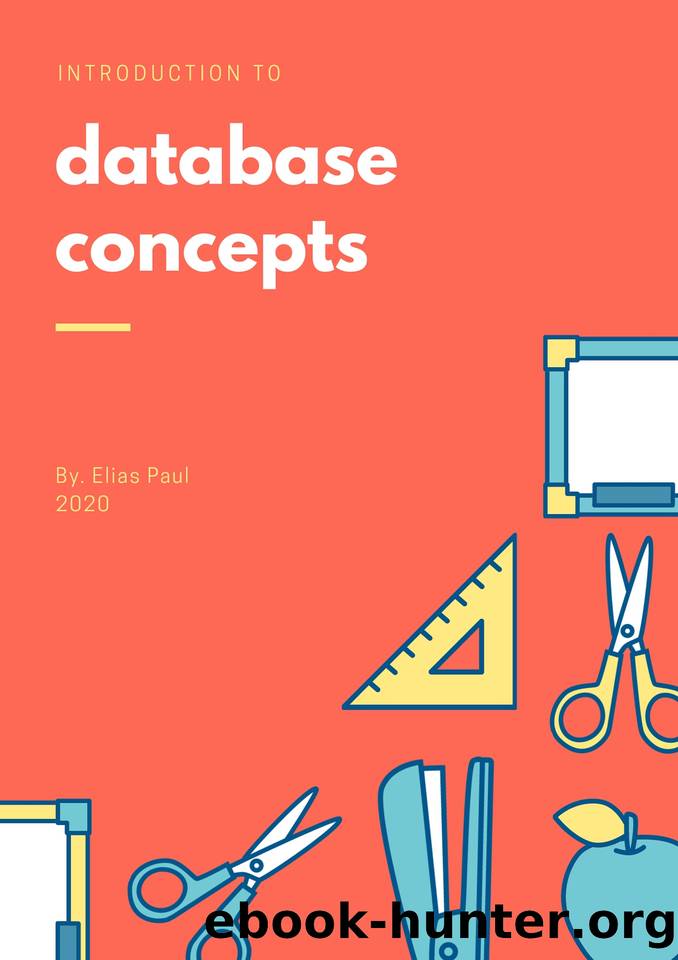Introduction to Database Concepts by Paul Elias

Author:Paul, Elias [Paul, Elias]
Language: eng
Format: epub
Published: 2020-06-20T16:00:00+00:00
introduction to BDR design
relationship in a certain normal way, for example in 2FN, can be converted in a set of relationships in a more desirable way, 3FN, and so successively. That is, this procedure is the successive reduction of a
given set of relationships to a more desirable form . It is important note that this procedure is reversible , it is always possible to take the output of the procedure and make it the input, which means it is not
loses information during the additional normalization process.
The three original normal forms of Codd and the normal form of Boyce / Codd are based on the concept of functional dependency . Will be given first a definition this concept to be able to define later when a relationship is in a certain normal way.
Proposed example
The example to be followed to clarify all definitions deals with very small form of a company that has a number of employees, those who know your NIF, your name, your address, a contact phone and his year of birth. This company has a series of projects uniquely identified by a code and whose name is known, your budget, your start date, your end date, the city where is developed and the degree of suitability of the project, this has to do with the ease of movement from the city where the headquarters of the company to the city where the project is developed and depends not only of the kilometers but also of the media that exist
among them according to a study done by the company itself. To the employees they can be assigned to work on different projects during a period of established time being able to alternate his work in different projects.
If we carry out the logical design based on the appropriate conceptual scheme, the schema of the database that we will obtain, regardless of the domains associated with the attributes, is the one shown below: EMPLOYEE (NIF, name, address, date-birth)
Primary key: NIF
CITY (city, suitable)
Primary key: city
PROJECT (code, name, budget, start, end, city)
Primary key: code
Foreign key: city → CITY
WORK (NIF, code, from, to)
Primary key: (NIF, code, from)
Foreign password: NIF → EMPLOYEE
Foreign password: code → PROJECT
But is the way we intend to store the information completely correct?
information? There are things that we are very clear that "are in place"
because it seems "natural". For example, it seems logical that if, in addition, we want to store the personal phone number of each employee, this data must be in the EMPLOYEE table.
Suppose no, that the employee's phone number is included in the table TO WORK.
89
Page 98
BD1 2006-2007
WORK (NIF, telephone , code, from, to)
Primary key: (NIF, code, from)
Foreign password: NIF → EMPLOYEE
Foreign password: code → PROJECT
A possible occurrence of the WORK table would be:
NIF
PHONE
CODE
SINCE
UNTIL
22446688A
5632224
A111
10/10/92
12/20/92
22446688A
5632224
A112
01/09/93
03/12/93
22446688A
5632224
A112
03/20/93
03/14/93
22446688A
5632224
A116
08/15/93
11/24/93
11116666B
5211111
A112
01/09/93
05/20/93
11116666B
5211111
A114
07/07/93
10/27/93
As we can see, the contact phone number of an employee is going to repeat as many times as projects is assigned. This redundancy can cause inconsistent information if possible handling is not handled carefully updates to an employee's contact phone number.
This problem arises because of
Download
This site does not store any files on its server. We only index and link to content provided by other sites. Please contact the content providers to delete copyright contents if any and email us, we'll remove relevant links or contents immediately.
Algorithms of the Intelligent Web by Haralambos Marmanis;Dmitry Babenko(8517)
Building Statistical Models in Python by Huy Hoang Nguyen & Paul N Adams & Stuart J Miller(7281)
Azure Data and AI Architect Handbook by Olivier Mertens & Breght Van Baelen(7278)
Serverless Machine Learning with Amazon Redshift ML by Debu Panda & Phil Bates & Bhanu Pittampally & Sumeet Joshi(7165)
Data Wrangling on AWS by Navnit Shukla | Sankar M | Sam Palani(6930)
Driving Data Quality with Data Contracts by Andrew Jones(6910)
Machine Learning Model Serving Patterns and Best Practices by Md Johirul Islam(6656)
Learning SQL by Alan Beaulieu(6151)
Weapons of Math Destruction by Cathy O'Neil(6073)
Big Data Analysis with Python by Ivan Marin(5682)
Data Engineering with dbt by Roberto Zagni(4671)
Solidity Programming Essentials by Ritesh Modi(4335)
Time Series Analysis with Python Cookbook by Tarek A. Atwan(4172)
Pandas Cookbook by Theodore Petrou(3899)
Blockchain Basics by Daniel Drescher(3418)
Hands-On Machine Learning for Algorithmic Trading by Stefan Jansen(2953)
Natural Language Processing with Java Cookbook by Richard M. Reese(2901)
Feature Store for Machine Learning by Jayanth Kumar M J(2856)
Learn T-SQL Querying by Pam Lahoud & Pedro Lopes(2842)
